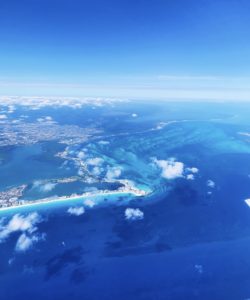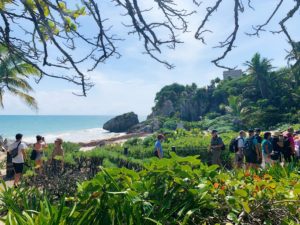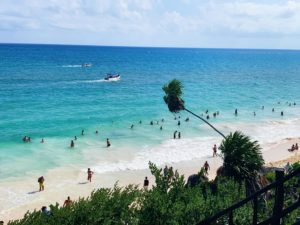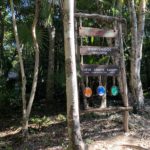Adventure
What We Learned Traveling to Tulum, Mexico
 Rental Car
Rental Car
Essential. Renting a car from Alamo was nice and convenient. We stayed at a villa so they dropped the car off to us and picked the car up the morning we were leaving. The staff was very professional and efficient. The only downside was when I wanted to make a change to the reservation to extend the car another day. The struggle was real. Trying to get in touch with someone while I sat by the pool didn’t make it better, either. It was a series of long wait periods, finally getting through and then being hung up on. I am not sure if this was just a fluke experience or if this is the consensus of dealing with Alamo by phone in Mexico. If anything, this experience gives a whole new understanding of trouble in paradise.
People drive extremely fast on Highway 307.
I want to take a moment and talk about the layout of this area of Mexico.
Akumal and Tulum are used synonymously. Even when we asked the locals to explain the distinction, they could not offer a set answer. If you rent a car (recommended), this will be something you will sort out quickly though. This is what I would note going in: off Highway 307 you can get to downtown Akumal. There you want to go to places like La Buena Vida. If you put La Buena Vida in your GPS, you will hit the area worth exploring. You can also get to Tulum’s boutique hotels which is roughly 30 minutes or less from Akumal’s downtown. The space between these locations is the highway of which many of the resorts and excursions are located.
My favorite part of driving was the Retornos on the highway. This is the turn around for the highway in order to get to places on the other side of where you currently are. The turn around is not like those in New Jersey where you exit right, which brings you to a jug handle that takes you around to a safe red light. In fact, I hate Jersey driving, but retornos gave Jersey driving a logical structure in my mind.
Not trying to take away the fun of you figuring this out, but the retorno entrance is through the left, inside lane, which is typically the fast lane and many of them come up short and without lighted warning.
Use your left signal to tell cars that they can go around you. This is particularly fun with a backseat full of family yelling “Retorno!” every time you miss one.
Cell phones
Check to make sure Mexico is included in your data plan. Dealing with AT&T and Verizon — they both have Mexico included in the unlimited talk and text. At least they did for the plans involved in our trip. Always check before leaving the country.
Still, both services had issues. Verizon service kicked in about three hours after landing in Mexico. AT&T had to be contacted to lift the restricted access, though they had been called prior to leaving for Mexico so that this wouldn’t be an issue. Things happen.
Pesos vs. American Money
Make sure you have tip money. This should be in American Dollars. We ran into these guys at the airport who travel to Mexico all the time and they said the USD goes much further due to the exchange rate in Mexico.
I would keep about 5,000 pesos on you. We exchanged money through Travelex at the airport in the states. I should have researched prior, but Travelex pretty much has the same rates as the banks .. and apparently they are not the best rates– so we made an error there. I would recommend exchanging money in Tulum while you are out because they have local exchange ATM facilities that look like huts called Casa de Cambio. Translation — money exchange house. These money exchange houses compete to give the best exchange rate. Otherwise, your resort should have a location where you can exchange your money. Worst comes to worse, everyone accepts USD. If you are walking around exploring and buying food, especially where the Mayan Ruins of Tulum are, businesses are all cash for the most part. Who doesn’t want to drink a coconut on the walk to the Ruins entrance? Some businesses have a means for credit card exchange, but internet service doesn’t always allow for use. You will also find a Starbucks and a Subway cornered between locals suspended by their ankles spinning around a pole upside down.
I do suggest going to the Mayan Ruins in Tulum, though I was disappointed to not be able to go in the ruins or close to them for that matter. You cannot climb them as advertised in the pictures, or at least you couldn’t on this visit. Still, after exploring, the ocean is open for a dip and it is amazing! On top of that, the park workers will gladly take pictures of you — even after you accidentally go too far into unchartered territory to find out that the reason why no one is allowed over there was because there was a nest of turtles. This does not feel like the tourist traps I have seen in other countries with historical locations of note.
You will also notice that the USD exchange rate varies based on vendor of exchange, so look around for the best deal. Each store or restaurant will have their own exchange rate sign for the dollar. I am not sure how they are not getting into trouble pedaling different rates set by the banks. From what I understand, because they provide you with a service, they can charge whatever they want to provide that service. Make sure to let whoever is charging your card know that you want to be charged in pesos, especially those out of state so they do not double charge you for converting from pesos to USD to X (whatever you currency is). A helpful article to understanding this can be found on WalletHub. Always research what the rate is and get an idea for what things should be prior to traveling.
When we were there, it was 16 pesos = $1. This changed daily, sometimes a small amount and sometimes by a lot. This depends on what is happening in each country and the economic systems that support it. The lowest Mexican monetary paper unit is a unit of 20 peso note.
For a quick look at the break down, I suggest going here: https://www.mexperience.com/lifestyle/mexico-essentials/money-in-mexico/.
Booking Excursions:
We booked excursions online once we arrived in Mexico, though we had done plenty of research before.
One of the excursions we booked online through the Tiqets App was the Mayan Ruins of Tulum: Fast Track. We paid $12 per person. If you want to bring in a GoPro, professional camera, drone (I have read that customs charges 16% taxes based on the price of the drone, so keep a receipt of what you paid so you don’t get charged improperly) or selfie stick, you need to pay a fee at the ticket office.
We were assured we could use our mobile passes here, but in fact, we could not. The walk from the Mayan Ruins entrance to the parking area is a little bit of trek, especially if you are traveling with people not accustomed to foot commuting. Our crew walked back to the Parking area and was sent into one of the souvenir trinket stores to get our tickets. Once we had them in hand, we were able to go past the line formed at the Main Entrance.
The one excursion we booked ahead of time was Aktun Chen, which we planned for our first day in Tulum. You need to print your tickets for this as well and make sure to bring tip money to give to your drivers. Because this cave exploring, ziplining and cenote swimming adventure is associated with National Geographic, it seemed an easy first day experience. In fact, it was. The facility offered convenience and had all of the adventures in one place. The monkeys and parrots are a plus here and they offer a lunch as part of the deal. The only complaint I have about the experience is that you can not use your cell phone when ziplining and the pictures were only sold as a set. There were some pictures we loved, but the set was 80 USD. That seemed too high for the three pictures that worked in our group’s favor.
When you get picked up for excursions, it is usually in front of the hotels at the security gates. The pickup people usually drive white vans and will call out the names of those they are charged to transport. You just hop on the bus and go from there. Ask your hotel for a map of the location of the security gates.
All along highway 307, there are cenotes and things to do! You can literally not have a plan for the day, drive along the highway and stop off wherever you want. We would have done more, but it was our first time and we needed relaxation.
One of the list items we were trying to knock off was to go to the Pablo Escobar House located in the Mexican beach resort of Tulum Casa Malco. It is a hotel with quirky style choices. It is nice to take a break from your day and have a drink here while you sit on the beach, do a little swinging (from a tree swing…) or look out from the rooftop. It is a great place to remember how to play and enjoy a little decadence.
Going to Other Hotels in Tulum
This review is not about discounting experience, so without naming which, I will say all inclusive days did not work for us. The cost was 60 USD per day and the beaches were play penned in by these peculiar tubes that kept the water calm but did not add to the ambiance.
We tried the pool. It looked fun for those drinking the watered down mojitos and cozying up to the pool bar– but that didn’t quite fit the mood or crowd we were with. The food was perfect for hungry teens, but I haven’t been able to eat that way since I was a hungry teen. In fact, I haven’t been able to drink watered down sweet cocktails since then either.
There was this one night that a coffee drink made us all happy.
We decided to turn to the oceanfront boutique hotels in Tulum where you can rent a cabana for the day. Our favorite place was the Papaya Playa Project. They had a $50 food and drink minimum. Not many of the other boutique hotels charged $50. This place is the best. One of our favorite dishes was the Tuna Tartar, but everything was fresh, delicious and honestly — healthy.
Another boutique hotel to go to is La Zebra. While learning that the shaded cabanas there are reserved for hotel guests, it is just as beautiful. Worth going to see.
The road is filled with options, most reserved for hotel guests and many of them offering only lounge chairs. The perfect day was had (twice) at the Papaya Playa Project. And no, we are receiving nothing for the endorsement. Pure and simple: the place is amazing.
Parking in Tulum
When we visited the Papaya Playa Project we were able to park right on the street near the entrance of the hotel. Every hotel or place that is a location to visit has their own parking lot. PPP is at the beginning of a VERY long strip to explore, and the strip continues after a span of undeveloped oceanfront, so don’t stop short.
After the day-time cabana sessions were over at 5pm, we would head out to go find a restaurant to have dinner. Since we were going to be in Tulum late and wanted to walk around, we parked in a lot we felt was a good mid-point on the strip. It is across from a place called Camping Chavz. This particular lot charged 10 USD or 150 Pesos. They stayed open until midnight, so this was a great deal. If you are going into Tulum for the day, there are more lots like these all over..
You can also rent bikes. We saw a lot of people riding bikes. This depends on how adventurous you are. Parts of the road get clogged up and can get kind of narrow. I recommend bikes only during the day.
Regardless of how you choose to commute, make sure you go to these areas of Mexico.







